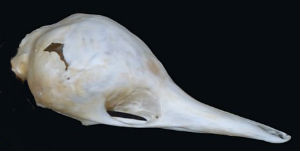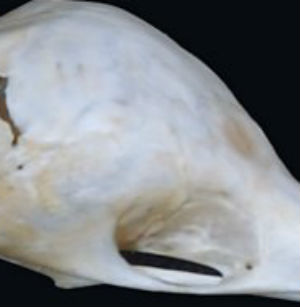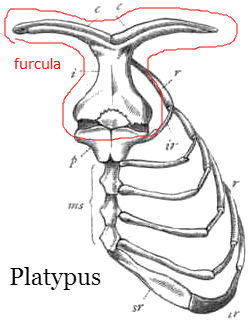The following is a list of traits linking monotremes with birds. Living monotremes include the platypus and echidnas. Additional traits linking these animals to birds are listed on a separate page of this website which discusses the possibility of bird-mammal hybrids.
EGGS
Monotremes incubate and hatch eggs outside the body (like birds). Reptiles do not incubate eggs. "Monotremes lay eggs that are telolecithal (the yolk is concentrated toward the vegetal pole of the ovum) and meroblastic (early cleavages are restricted to a small disk at the animal pole of the ovum) like bird eggs but unlike the reproductive processes of therian mammals [i.e., of all other mammals]" Vaughan et al. (2011, p. 76).
EARS
In a symposium presented to the Australian Mammal Society, Augee (1974, p. 90) stated that "Both the platypus and echidna have rudimentary external ears." Although nearly all non-aquatic mammals other than the monotremes do have external ears (pinnae), birds do not.
SKULL/BEAK
Iggo et al. (1985, p. 261) say the skin of the beak has an outer, heavily cornified layer. And Augee et al. (2006, p.34 ) concur, saying that on the beak of an echidna "The outer layer of the skin is heavily keratinised." The nostrils of kiwis, unlike those of all other birds, are located at the tip of the beak (Roots 2006b, p. 10). The same is true of echidnas. "The adult echidna skull "is bird-like, with a large, domed cranium and long tubular snout. The snout is comprised of long, thin extensions of the premaxillary, septomaxillary and maxillary bones " (Augee et al. 2006, p. 38). In monotremes the cranial sutures vanish at an early age, the bones of the head in adult specimens being united together and smooth as in birds, and not connected by sutures as is the case in other mammals (Augee et al. 2006).
 Skull of an echidna (note bird-like shape)
Skull of an echidna (note bird-like shape) Echidna cranium: Close-up to show lack of sutures
Echidna cranium: Close-up to show lack of suturesTEETH
In monotremes the young have an egg tooth that helps them emerge from the egg, as do hatchling birds (Augee et al. 2006, p. 37, Vaughan et al. 2011, pp. 76, 81). Otherwise, teeth are absent (except in young platypuses), as in birds (Vaughan et al. 2011, p. 75). "Echidnas completely lack teeth. No indication of vestigial dentition has been detected in studies of echidna embryos. As far as the fossil record is concerned, echidnas have never possessed teeth, and no intermediate between a toothed monotreme and a prehistoric echidna has yet been found" (Augee et al. 2006, p. 38).
EYES
The cartilaginous layer beneath the scleral layer of the eyeball is characteristic of reptiles and birds (Augee et al. 2006, p. 55).
CLOACA
Monotremes of both sexes have a cloaca (as do birds, reptiles and amphibians). A cloaca is a common chamber into which the intestines, the reproductive ducts, and urinary ducts vent (Vaughan et al. 2011, p. 120).
TESTES
Monotremes and some tenrecs (and no other mammals) have internal testes, as do birds (Walker 1999, pp. 7, 186). In other mammals the testicles are contained in an external pouch (scrotum).
Likewise, in both the platypus and echidnas, the spermatozoa are filiform, as are those of a bird, and as those of other mammals are not (Bedford and Rifkin 1979, Warren et al. 2008).
OVARIES
Only the left ovary is functional in platypuses, as is the case in birds (Asdell 1964). In echidnas, both are active, as in mammals (Vaughan et al. 2011, p. 76).
PROSTATE
Monotremes are the only mammals that lack a prostate gland (Roberts 1972, p. 882). This is another avian trait: no bird has a prostate (McDonald 2011, 1996).
COCHLEA
"The cochlea of the inner ear in most mammals is coiled like a snail shell and in humans has two-and-three-quarter turns. In the echidna the cochlea has a banana-shaped curve with only a three-quarter spiral turn…which is reminiscent of avian and reptilian cochleae." (Augee et al. 2006, p. 62).
LAGENAR MACULA
Otolith endorgans, which are present in the inner ears of many animals, function in balance and orientation. Non-mammalian vertebrates possess a third otolith endorgan, the macula lagena, not present in mammals other than monotremes. According to Dooling et al. (2000, p. 72), "The lagenar macula is an otolithic organ present in all nonmammalian vertebrates and in monotreme mammals" (see also: Ladhams and Pickles 1996).
CORACOID
Coracoid bones are present in monotremes (Walker 1999, vol. 1, p. 7). Wikipedia: "A coracoid is a paired bone which is part of the shoulder assembly in all vertebrates except therian mammals" (i.e., all mammals other than monotremes).
 Furcula of a platypus
Furcula of a platypus
INTERCLAVICLE/FURCULA
An interclavicle is present in most extant birds and many extinct reptiles, but not in mammals other than monotremes. Together with the clavicles, it forms a furcula, the same structure known in domestic fowl as a "wishbone" (Wikipedia ), Proctor and Lynch (1998,p. 214); Tschopp and Mateus (2013); Walker (1999, vol. 1, p. 7).
HEART
After dissecting platypus hearts and reviewing the relevant literature, Lankester (1882, p. 556) concluded that the action of the right auriculoventricular valve in platypuses "differs importantly from that of the valve of other mammals, and resembles that of the fleshy valve of birds and reptiles."
TEATS
Teats are present in all mammals other than monotremes (Marshall 1979). Obviously, birds lack them, too.
EMBRYO
Augee et al. (2005, p. 31) note that in monotreme embryos "Paired strips of bone (the pilae antoticae) arise from the base of the chondrocranium. Their function in montremes is uncertain, and they appear to be vestigial. They are not present in any other living mammals, but they are found in reptiles and birds where they form a large part of the braincase. A cartilaginous scleral cup or ring supporting the eyeball develops in the chondrocranium and persists in the adult monotreme eye. This structure is likewise absent from other living mammals but does occur in birds (and reptiles).